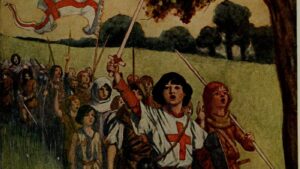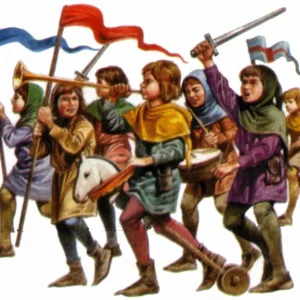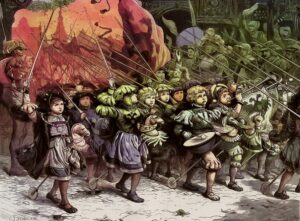The Middle Ages witnessed a series of astonishing and sometimes bewildering historical events. One such event is the Children’s Crusade, an enigmatic chapter that unfolded between the 11th and 13th centuries. Captivating and heartrending, this unique movement saw thousands of young people embarking on a quest to reclaim the Holy Land. Let us delve into the peculiar and tragic events surrounding the Children’s Crusade and explore its historical significance.



The Call to Crusade:
In the early 13th century, Europe found itself entrenched in religious fervor, with ideas of pilgrimage and conversion permeating society. Among this atmosphere of heightened piety emerged a call for a crusade to recapture Jerusalem from Muslim control. However, a unique twist emerged as the call extended to children, who were seen as pure and innocent in the eyes of God.
The Peculiar Beginnings:
Historical accounts are shrouded in ambiguity, leaving us with limited knowledge about the specific events surrounding the Children’s Crusade. Reports suggest that in early 1212, a charismatic twelve-year-old French shepherd boy, Stephen of Cloyes, claimed to have received a divine vision calling for the liberation of the Holy Land. Consequently, he amassed an astonishing following of children and decided to embark on a journey to reclaim Jerusalem.
The Misguided Journey:
The Children’s Crusade took place in two main waves, each following different paths towards their final destination. The first wave, led by Stephen of Cloyes, made its way through France. As they reached the Mediterranean, they hoped for a miraculous parting of the sea, similar to Moses’ Exodus. However, faced with insurmountable obstacles, exhausted and desperate, the group disbanded, and many children returned home disappointed.
The second wave of the Children’s Crusade, led by a young German boy named Nicholas, followed a different route. They traversed from Germany to Italy, aiming to sail directly to the Holy Land, bypassing the hardships of an overland journey. Unfortunately, they faced severe exploitation along the way, and most never reached their intended destination. Many were sold into slavery or perished at sea.
Controversy and Legends:
Historical records surrounding the Children’s Crusade are far from comprehensive, and the event is heavily debated in academic circles. Skeptics argue that the Children’s Crusade might have been exaggerated or entirely fabricated by chroniclers of the time. Regardless of the exact details, the Children’s Crusade continues to captivate scholars and historians alike due to its cultural and psychological implications regarding the fervor and desperation of the era.
Legacy and Significance:
The Children’s Crusade, despite its ambiguous origins and devastating outcomes, holds historical significance due to its impact on society and the perception of children during medieval times. The event revealed a society deeply entrenched in religious zealotry, where the notion of children as innocent and devout beings played a pivotal role.
Moreover, the occurrence of the Children’s Crusade serves as a reminder of the exploitative and manipulative aspects that existed within the context of crusading fervor. It serves as a poignant lesson on the dangers and consequences of blind faith and the manipulation of youth for political and religious purposes.
Conclusion:
The Children’s Crusade remains one of the most peculiar and tragic chapters in medieval history. With its young participants and their zealous pursuit of a divinely ordained mission, the event continues to intrigue and perplex us to this day. While the exact details may remain elusive, its significance lies in its reflection of the historical context, social dynamics, and the vulnerability of human nature in the face of religious fervor.

